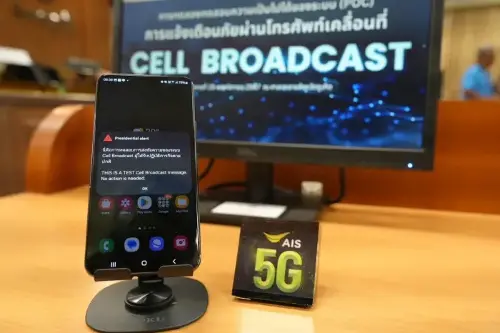
Advanced Info Service Plc (AIS) and the National Broadcasting and Telecommunications Commission (NBTC) conducted trials on Tuesday of the cell broadcast emergency alert system on the company's live telecom network in Phuket in preparation for full system integration with the national alert system.
Waroonthep Watcharaporn, head of business relations at AIS, said the cell broadcast technology allows messages to be sent directly to mobile phones in specific areas.
This technology is ideal for emergency alerts because it can simultaneously send messages to all 4G and newer mobile devices within the coverage area of a specific base station, he said.
The messages will appear on mobile screens as pop-up notifications in near-real-time, enabling immediate awareness of situations.
Mr Waroonthep said AIS developed the service thanks to NBTC funding from the Broadcasting and Telecommunications Research and Development Fund for Public Interest, which supported several telecom operators in building cell broadcast systems for the project.
This support also enabled AIS and other telecom operators to conduct cell broadcast technology trials in Phuket, which achieved the desired goals.
The live network testing served as a proof-of-concept simulation for emergencies and natural disasters. These successful trials build confidence in the safety and security of the lives of citizens and tourists alike, said Mr Waroonthep.
Trairat Viriyasirikul, acting secretary-general of NBTC, said the regulator collaborated with the Digital Economy and Society (DES) Ministry, the Department of Disaster Prevention and Mitigation (DDPM), and all telecom operators to develop an emergency alert system via mobile networks or the cell broadcast system.
Responsibilities were distributed among agencies to ensure a functional cell broadcast system will benefit the public. By the second quarter of 2025, the system is expected to be operational in some parts of the country.
Under the responsibilities, the DDPM is the main agency in determining the content and area for message dissemination. This role is called Cell Broadcast Entity (CBE).
The DES Ministry oversees the cloud server system and connectivity between the CBE and the Cell Broadcast Centre.
The telecom operators are responsible for delivering the alert messages to mobile phones in affected areas.
The NBTC office provides funds for the cell broadcast system development to three mobile operators: Advanced Wireless Network, True Move H Universal Communication, and National Telecom.
Mr Waroonthep said AIS's network covers more than 95% of the population.
The company wants to expand into remote areas to ensure that the cell broadcast alert system provides equal and comprehensive safety to all citizens.
